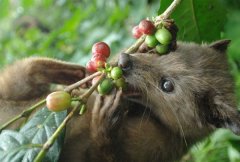Major Coffee producing areas in the World (1)
Coffee production zones (commonly known as coffee belts) range from 25 degrees north latitude to 30 degrees south latitude, covering many countries in Central, West Africa, the Middle East and South Asia, the Pacific, Latin America and the Caribbean. The reason why coffee cultivation is concentrated in this area is mainly due to the limitation of temperature. Because coffee trees are vulnerable to frost, the north or south latitude is not suitable, the tropical area is suitable, the heat and humidity in this area is ideal.
The ideal climate for coffee trees to grow is in the tropics on both sides of the equator, where they benefit from the ideal temperature (24 ℃ ~ 26 ℃ for Robastian coffee and 20 ℃ ~ 25 ℃ for Arabica coffee) and humidity that is important to them (1 500 to 2,000 mm annual precipitation). Robasta coffee grows at an altitude equal to sea level, while Arabica coffee grows in highly acidic soil at higher elevations (800 to 2000 meters), which is necessary for it to produce aroma. Arabica coffee grows well in mineral-rich, fertile and well-drained volcanic soils in Central America and the Caribbean.
Coffee trees are sensitive to high temperature. they often grow in the shadow of broad-leaved trees such as bananas; these trees protect them from direct sunlight, which kills coffee flowers. The banana tree is planted where it can protect the coffee tree, which in turn provides shade to other plants planted under it, and so on. Coffee trees are also sensitive to frost, and for this reason, they are rarely found above 2000 meters above sea level.
At present, the important coffee beans in the world mainly come from Arabian coffee, which is of better quality and more expensive.
China
China's coffee producing areas are mainly in Hainan, Yunnan and Guangdong; the northern part of Hainan Island in China, the southern part of Yunnan Province, is located between 15 degrees north latitude and the Tropic of Cancer, which happens to be in this golden zone. The day and night temperature in its coffee is not too strong and bitter in South America, India and Africa, but strong but not bitter, fragrant but not strong, very unique. With a little fruity flavor, it is the top grade of coffee, and many countries praise "the best quality coffee in the world" and are rated as "high quality products, mellow first" by the Lenton international coffee market.
Taiwan area of China
Taiwan in China is located in the subtropics, with mountains and obvious rainy season, which is a good growing environment for coffee. Since the British introduced coffee trees during Guang Xu's time, the planting scale has not been large. At present, there are still small-scale growers, including Huilin Farm (more than 1,000 meters above sea level) in Nantou Mountain area, and Hebaoshan Coffee in Yunlin Gukeng (294 meters above sea level). The flavor of coffee by-products is close to that of Central and South American beans, with soft sour taste and good texture, and the taste is peaceful, while the coffee beans in Huilin Farm are said to be less acidic.
Brazil (Brazil)
Coffee production accounts for 1 / 3 of the world's total. Although it occupies a very important position in the whole coffee market, it is the largest producer. However, because the Brazilian coffee industry has been adopting the strategy of low price and large number of planting, the coffee produced is of average but less excellent quality, which is generally regarded as an indispensable coffee bean in mixing and blending. Santos is more famous among the many varieties of Brazilian coffee.
Colombia (Colombia)
Colombia is the second largest producer in the world, accounting for 12% of the world's total output. Its coffee beans are of good quality. Coffee trees are planted in highlands, cultivated in small areas, carefully harvested, and processed by wet processing. The coffee produced is beautiful in quality, rich and unique in flavor, whether it is a single drink or a mixture.
Important Notice :
前街咖啡 FrontStreet Coffee has moved to new addredd:
FrontStreet Coffee Address: 315,Donghua East Road,GuangZhou
Tel:020 38364473
- Prev

Like the difference between shit coffee and Kopi Luwak
Recently, like shit coffee is so hot that every major Weibo has released and reprinted it, which instantly took away the title of Kopi Luwak as the most expensive coffee. But it doesn't make sense to think about it carefully. Elephant food is mainly composed of tender branches and leaves, wild fruits, weeds, tender bamboos, wild vegetables and other plants. It probably likes coffee fruit, too. (much better than grass or something) but elephants must not go to the coffee garden, so
- Next

Matcha coffee
Matcha coffee has a strong gentle color. Here, hand-brewed coffee brewed with filter paper is also used to show this oriental matcha coffee, so that the deep-roasted beans are filtered by fine filter paper to show a rich and gentle taste. Raw material: * fresh roasted coffee 20g * matcha powder a little * sugar 1 teaspoon * appropriate amount of fresh cream: matcha coffee is filled with Japanese style
Related
- Beginners will see the "Coffee pull flower" guide!
- What is the difference between ice blog purified milk and ordinary milk coffee?
- Why is the Philippines the largest producer of crops in Liberia?
- For coffee extraction, should the fine powder be retained?
- How does extracted espresso fill pressed powder? How much strength does it take to press the powder?
- How to make jasmine cold extract coffee? Is the jasmine + latte good?
- Will this little toy really make the coffee taste better? How does Lily Drip affect coffee extraction?
- Will the action of slapping the filter cup also affect coffee extraction?
- What's the difference between powder-to-water ratio and powder-to-liquid ratio?
- What is the Ethiopian local species? What does it have to do with Heirloom native species?

